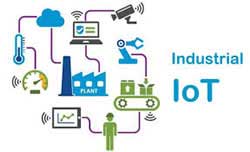IoT, IIoT, “smart” objects. Our world is becoming more and more connected every day. What is the IIoT “Industrial Internet of Things” and what does it mean for manufacturing?
Let’s begin by clearing up the differences between the IoT and the IIoT. Sometimes used interchangeably, there are some important differences to note. First, let’s examine the IoT.
The IoT is used to describe connecting the physical world to the digital world, specifically relating to consumer usage. This is where “smart objects” come in. Anything from phones to cars, appliances to your home itself can be a smart object if it connects to the internet, passing data to and from those objects.
The IIoT also deals with internet-connected objects. However, the usage is more specific to industrial purposes, such as manufacturing. Where the IoT focuses on connectivity to give consumers benefits of convenience, the IIoT connects devices to provide greater data visibility, improve performance or enable automation.
The Industrial Internet of Things (IIoT) is revolutionizing the manufacturing industry perhaps more than any other industry or sector. Here are three IIoT trends in manufacturing that have already begun to take hold.
3D Printing
One trend is 3D printing, also known as additive manufacturing. The 3D process recently began to merge with IIoT in order to guarantee better product quality. Sensors pick up information from a 3D printer, and is then used to determine any production problems.
Asset Tracking and Predictive Maintenance
IoT helps manufacturers by gathering data from assets positioned throughout the value chain. The assets then relay the information to a central system. These Internet-connected assets are able to communicate with the system, letting it know of their status. This process, called “predictive maintenance,” enables a company to identify and address possible defects that could spell trouble later.
Autonomous Robots
Robotics has been a part of the manufacturing industry for a number of years, and, driven by IoT, its influence will only increase. Autonomous robots are being used increasingly by manufacturers for a number of things: working alongside humans to achieve efficiency and productivity, performing actions normally performed by humans to reduce injury, and improving momentum and accuracy in places like factories and warehouses. These examples demonstrate the practical application of the IIoT in the manufacturing environment, but the benefits are not limited to 3D prints, asset tracking or robots on the factory floor. Through connected devices, the IIoT can provide better data collection and visibility to drive smarter business decisions, while minimizing downtime and boosting productivity.
At Radley Corporation, we’re focused on streamlining processes and automating data collection in the manufacturing industry. Our Machine Monitoring and PLC Integration solutions bring together the IIoT to truly maximize on your data through machine-to-machine connectivity, business intelligence and process improvements.

